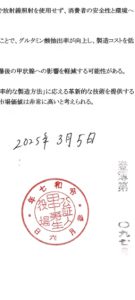発明の名称 麩および昆布を用いたグルタミン酸ナトリウムの効率的製造方法
- 2025.03.10
- 試作品制作
発明の名称
麩および昆布を用いたグルタミン酸ナトリウムの効率的製造方法
技術分野
本発明は、食品素材である麩(小麦グルテン)および昆布を原料とし、両者の特性を活用した革新的なグルタミン酸ナトリウム製造技術に関するものである。特に、従来の発酵法や酸加水分解法を回避し、放射線や遺伝子組み換えを使用せず、天然素材を基にした高効率な製造方法を提供する。
背景技術
従来、グルタミン酸ナトリウムは発酵法や酸加水分解法により製造されてきたが、これらの方法はコストが高く、化学薬品の使用や廃棄物処理に課題がある。また、遺伝子組み換え技術や放射線照射を用いた方法が市場に登場しており、消費者の健康や環境への影響に対する懸念が高まっている。
発明の目的
本発明の目的は、麩および昆布を原料に使用し、これらの天然成分を活かして効率的にグルタミン酸ナトリウムを製造する方法を提供することで、以下の課題を解決することにある:
放射線照射や遺伝子組み換えを使用せず、消費者にとって安全かつ安心な製法を提供。
効率的でコストを抑えた製造プロセスを確立し、環境への負荷を低減。
昆布由来のヨードを活用し、放射能被曝の影響を軽減する可能性を提供。
課題を解決するための手段
混合抽出工程
麩と乾燥昆布を1:1の重量比で混合し、50〜60℃の温水に懸濁させる。これにより、麩からのグルテン由来のグルタミン酸前駆体と、昆布に含まれる遊離グルタミン酸を同時に抽出する。このプロセスは、両者の相乗効果によって、抽出効率が向上し、製造コストの削減に寄与する。
酵素加水分解工程
抽出液にプロテアーゼを添加し、グルテンを部分加水分解することで、グルタミン酸前駆体をより効率的にグルタミン酸に変換する。この工程により、昆布成分がグルテンの膨潤を助け、酵素反応を均一に進行させる。
中和・精製工程
得られた反応液を濾過後、水酸化ナトリウムを使用してpH7に調整し、グルタミン酸をグルタミン酸ナトリウムに変換する。
結晶化工程
溶液を減圧下で濃縮し、冷却することでグルタミン酸ナトリウムを結晶化させる。結晶化後、遠心分離により高純度のグルタミン酸ナトリウムを回収する。
効果
本発明により、以下の効果が得られる:
天然素材の使用:麩および昆布を原料とし、遺伝子組み換えや放射線照射を使用せず、消費者の安全性と環境への配慮を実現。
高効率なグルタミン酸ナトリウム製造:昆布と麩を組み合わせることで、グルタミン酸抽出率が向上し、製造コストを低減。
健康への配慮:昆布由来のヨードを利用することで、放射能被曝後の甲状腺への影響を軽減する可能性がある。
本発明は、現代の消費者が求める「安全」「環境に優しい」「効率的な製造方法」に応える革新的な技術を提供するものであり、特に健康や食品に対する意識が高まる中で、その市場価値は非常に高いと考えられる。
💕
Invention Title:
Efficient Production Method for Monosodium Glutamate Using Wheat Gluten and Kelp
Field of Technology:
This invention pertains to a novel method for producing monosodium glutamate (MSG) using wheat gluten (fu) and kelp as raw materials. This process harnesses the unique properties of both materials, avoiding traditional fermentation and acid hydrolysis methods. It represents a new, sustainable, and cost-effective approach to MSG production, focusing on natural, non-GMO and non-irradiated ingredients.
Background Art:
MSG has traditionally been produced via fermentation or acid hydrolysis, both of which come with high costs and environmental challenges. Additionally, with the growing use of genetically modified organisms (GMOs) and radiation in food processing, consumer concerns about food safety and environmental impact have increased.
Purpose of the Invention:
The objective of this invention is to provide a method for efficiently producing MSG using natural, non-GMO and non-irradiated raw materials—specifically wheat gluten and kelp. The invention addresses the following goals:
To avoid the use of genetic modification or radiation, providing a safe, consumer-friendly alternative.
To establish an efficient, cost-effective production process.
To potentially offer health benefits by leveraging natural iodine from kelp, which has been shown to help mitigate thyroid issues in cases of radiation exposure.
Solution to the Problems:
Mixed Extraction Process:
Wheat gluten and dried kelp are mixed in a 1:1 weight ratio and suspended in water heated to 50–60°C. This process extracts both the glutamic acid precursors from the gluten and free glutamic acid from the kelp simultaneously, creating a synergistic effect that enhances extraction efficiency and reduces manufacturing costs.
Enzymatic Hydrolysis Process:
A protease is added to the extraction solution at a pH of 6.8, partially breaking down the gluten into glutamic acid. This process is aided by the natural components of kelp, which help control the viscosity and maintain enzyme reaction uniformity.
Neutralization and Refining Process:
The filtered solution is neutralized to pH 7 using sodium hydroxide, converting glutamic acid into monosodium glutamate.
Crystallization Process:
The solution is concentrated under reduced pressure and cooled to induce the crystallization of monosodium glutamate, which is then separated via centrifugation, yielding MSG with a purity of 99% or higher.
Effects of the Invention:
This invention offers several significant advantages:
Natural Raw Materials: By utilizing wheat gluten and kelp, the process avoids genetic modification and radiation, providing a safer, more consumer-friendly production method.
Increased Efficiency: The combined use of wheat gluten and kelp results in a higher yield of glutamic acid and reduces production costs.
Health Considerations: The natural iodine present in kelp may offer potential health benefits by supporting thyroid function in the event of radiation exposure, providing additional value beyond MSG production.
This method addresses modern consumer concerns regarding food safety, sustainability, and environmental impact. It not only provides an innovative, efficient way to produce MSG but also ensures that the process is aligned with a more natural, responsible approach to food manufacturing.
